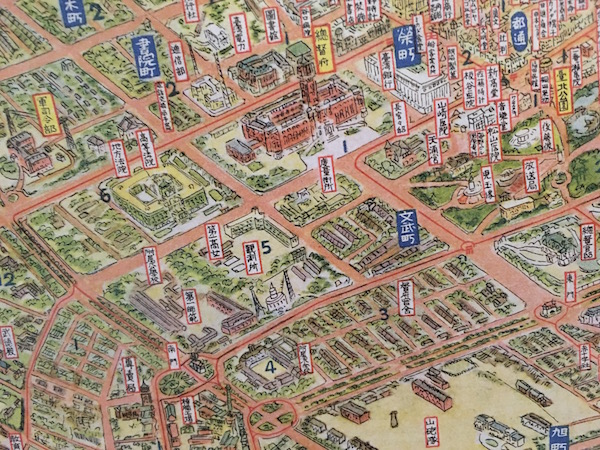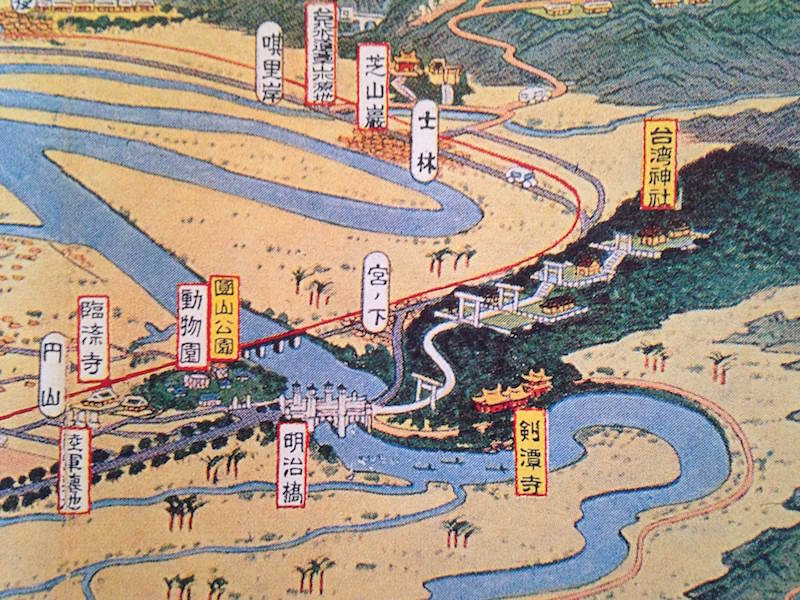Place Names Lost in Translation
A reading route prepared by Paul, Alison, Owen (FLAC only)
Image Credit: 臺北市大觀 (left: a close-up); 清代台北城 by 徐逸鸿 (right: a close-up)


[/et_pb_vertical_timeline_item][et_pb_vertical_timeline_item title=”Stop 2 (Maruyama/Yuanshan)” use_read_more=”off” animation=”off” text_font_select=”default” text_font=”||||” headings_font_select=”default” headings_font=”||||” use_border_color=”off” border_style=”solid”]
“Within the next two or three years, the remaining Japanese Shinto shrines would be cleared away from Maruyama and replaced by the Chinese palace-style Grand Hotel for foreign VIPs.” 128.
「其后两三年, 山上清除神社遗迹,建起中国官殿饭店,专门用来接待国宾」144.

“You recalled the unfinished trip you’d made the day after the big election. You reached Yuanshan, but saw passageways everywhere in the air, not knowing how to locate the route you’d taken hundreds of times at seventeen. Meiji Bridge — later you learned that’s what it was called. The handsome, straight, and even bridge, now overshadowed by a new one, was waiting to be demolished. The new rulers, who had criticized the ancient régime as an occupying power, had been in office four years, and the way they behaved was exactly like an occupying power.” 144
「你想起那一趟大选日后的未竟之旅,你走到圆山,之间空中地底条条是路,你迷失其间,不知该如何走到你十七岁是走过百遍的路。明治桥 — 你后来知道它原来叫明治桥,桥上的铜灯早在一场拆建时给李梅树买了放置在三峡的祖师庙了。平直美丽的桥被一座新桥压着待拆毁,批评以往是外来政权的新统治者人马已执政四年,所作所为写外来政权一样,只打算暂时落脚随时走人似的,不然他们何以去掉那两排在你们所有现存的人出生前就已在着的枫香呢?」156
[/et_pb_vertical_timeline_item][et_pb_vertical_timeline_item title=”Stop 3 (西门/北门/东门)” use_read_more=”off” animation=”off” text_font_select=”default” text_font=”||||” headings_font_select=”default” headings_font=”||||” use_border_color=”off” border_style=”solid”]
“Seimon-cho, now Ximen ding, was situated at the site of the long since demolished West Gate.” 198.
「西门町位于早拆掉的西门旧址。」192.
“Back then, North Gate had yet to be tyrranized by an overpass, so you could walk past it casually, feeling like one of your ancestors heading out of town a century before.” 113.
「有时搭客运,那时的北门尚未被任何高架路凌虐,你们轻松行经它旁边,便像百年前的先民一般有出城的感觉。。。」135.
“Extending to the south were #2 Girls High; Shinmachi Church, beneath a canopy of livistona and date palms; the Research institute of Taiwan Governor-General’s Office; the Medical Specialization Section of Taihoku Imperial University, which grandfather has attended; University Hospital; the headquarters of the Red Cross (you has to erase the tall office building of a certain political party, which was so disgustingly ugly it ruined the skyline); the clownlike, pitiable Keifuku Gate; the broad avenue at Tomon-cho, which was called neither Jieshou nor Kaidegelan, and the Taiwan Governor-General’s Mansion.” 188.
「州厅旁罗列南去的是第二高等女学校、浦葵海枣掩映的幸町教会、台湾总督府研究所、外公念的帝大医学专门部、赤十字本部(得把那栋丑怪特权破坏天际线的十几层某党部大楼抹掉)、小丑样的可怜的景福门、东门町不介寿路不凯达格兰大道上、台湾总督官邸,你总算看到它的后园了。」186.
[/et_pb_vertical_timeline_item] [/et_pb_vertical_timeline]
Analysis 1
Stop 1: This building is located in the Zhongzheng-qu or Zhongzheng District (中正区/中正區) of Taipei, which is named for President Chiang Kai-shek. The building was constructed during the period of Japanese rule but was converted once Chiang’s party took authority.
I think “machi” and “cho” are interchangeable (both mean ‘town’) and are used in the Japanese system of identifying addresses, similar to “qu” in Mandarin.
Although the Japanese district name Bumbu-machi 文武町 is different from the Mandarin one, it was from a Chinese street name during the Qing period: 文武庙街/文武廟街, which means “Street of the Temple of Cultural Deity (Confucius) and the Temple of the Martial Deity (Lord Guan).”
This is a good example of “palimpsest,” a single place that reveals the traces from multiple periods of time.
Analysis 2

Map Credit: A close-up from 臺北市大觀
Maruyama 圆山 in Japanese, or Yuanshan 圆山 in Mandarin, was a park in Taipei with shrines and other sites nearby. We suspect the translator chose Maruyama rather than Yuanshan to emphasize the place’s connection to the demolished Shinto shrines, perhaps because that is what was there when the narrator’s was young.

Photo Credit: Leah Suffern
The Grand Hotel was established in 1952, built on the site of the Grand Shrine (Shintoism). It was designed possibly as a way of impressing foreign dignitaries (particularly those from the West), as a symbol of Taiwanese power and wealth.
Analysis 3
Why is Seimon-cho spelled in Japanese rather than pinyin? Because:
- She is now traveling in Taipei playing the role of a Japanese tourist (Japanese identity)
- The market is designed by a Japanese (Japanese legacy)
- The area is more Japanese influenced (Japanese culture)
Jieshou 介寿 means “longevity of Chiang Kai-shek” (Jie is the Mandarin pronunciation of Kai as in Chiang Kai-shek 蒋介石), named in honor of, or course, Chiang. Kaidegelan is an aboriginal group, named in honor of the aboriginal group of Taipei. Bu negating both names of the same road, the narrator seems to show her disapproval of “politically correct” names over time.
What the narrator acknowledges is Tomon-cho, a Japanese name of the road between the East Gate (东门/東門 Tomon in Japanese, Dongmen in Mandarin) and the Presidential Office. Why? It is also very likely because her Japanese identity: She is now traveling in Taipei playing the role of a Japanese tourist.
